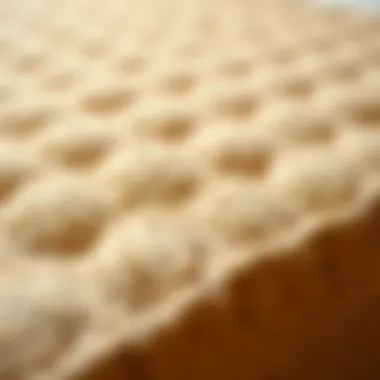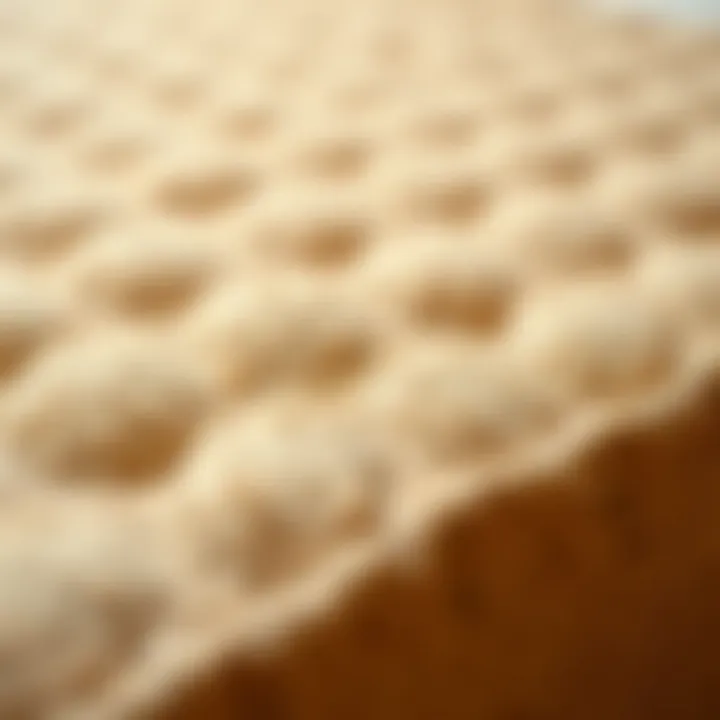Coir Mattress Topper: Benefits and Insights


Intro
In today's world of bedding choices, coir mattress toppers have emerged as a notable alternative, fusing comfort with sustainability. Crafted from the fibrous husk of coconuts, coir transforms a common tropical byproduct into a premium sleeping surface. As homeowners and designers seek more eco-friendly options, these toppers reveal unique properties that also cater to health-conscious individuals. When we navigate through this topic, it becomes apparent how coir compares both to synthetic materials and traditional fillings.
Moreover, as we delve deeper, we will explore how coir mattress toppers enhance the sleep experience while simultaneously championing ecological responsibility. This investigation doesn't just scratch the surface; it dives into market trends, potential future developments, and practical insights on maintaining these natural wonders. Let’s unpack what's making coir toppers the talk of the town among interior designers and DIY enthusiasts alike.
Furniture Trends
As bedding styles evolve, the focus on organic and sustainable materials grows stronger. The coir mattress topper fits perfectly into this narrative, aligning with contemporary design trends that prioritize environmental consciousness without sacrificing style or comfort. Here, we look at two significant components of furniture trends related to coir mattress toppers: current design trends and popular color palettes.
Current Design Trends
Lately, a noticeable shift toward minimalistic and sustainable designs has taken the spotlight. Coir mattress toppers reflect this shift. They not only add a touch of natural elegance but also promote a healthier sleeping environment. The texture of coir-influenced items has started appearing in bedrooms, blending seamlessly with organic cotton sheets and linen duvet covers.
Furthermore, employing coir enhances the appeal for minimalist aesthetics. Since coir is often left exposed in its natural state, it fits beautifully into interior setups emphasizing raw materials and earth tones. This approach aligns well with the grander narrative of sustainability in design, where less is more.
Popular Color Palettes
If coir mattress toppers could speak, they’d likely favor earthy tones — think shades of brown, green, or even deep blues reminiscent of the ocean. When selecting colors for the bedroom, many designers increasingly lean towards these earthy hues to complement the natural aesthetic coir brings.
- Earthy Browns: These colors echo the natural fibers of coir, providing warmth and comfort.
- Soft Greens: Reflect the tranquility of nature, promoting a restful atmosphere.
- Deep Blues: Reminiscent of the ocean, these tones can add a calming vibe to any space.
When combined with the coir mattress topper, such hues create a harmonic look, fostering an inviting environment conducive to relaxation and rest.
"A well-designed bedroom not only showcases style but fundamentally promotes a sense of well-being."
Practical Tips
To extend the lifespan and the benefits of a coir mattress topper, a few practical tips regarding maintenance and care are invaluable. Keeping these toppers clean and well-kept ensures your bedding retains its functional properties.
Furniture Maintenance and Care
- Regular Cleaning: Dust and dirt can accumulate over time, so gently vacuuming the topper using the brush attachment can help keep it fresh.
- Air it Out: Coir is naturally breathable, so placing it outside in the sun for a few hours can combat moisture and odors, ensuring it stays fresh and dry.
- Use a Protective Cover: Investing in a breathable mattress protector can shield the topper from spills and sweat, extending its longevity without compromising its natural benefits.
Space Utilization Strategies
When integrating coir mattress toppers into a sleeping environment, the approach to space can dramatically enhance the overall aesthetic:
- Layering: Combine your coir topper with other soft bedding materials like organic cotton or bamboo sheets for a cozy feel.
- Furniture Arrangement: Arrange your bed in a way that greets you with calm colors and textures, making it the focal point of the bedroom.
- Accessorizing: Simple, natural accessories like jute rugs or wooden bedside tables can further complement the cozy environment created with coir.
Coir mattress toppers resonate with the modern desire for sustainability in home decor. By combining aesthetic appeal with practical advice, individuals interested in enhancing their sleeping experience can find a reliable guide in understanding how to incorporate coir effectively.
The Basics of Coir Mattress Toppers
When it comes to comfortable sleep, the mattress we choose plays a significant role. Coir mattress toppers have emerged as a notable choice for homeowners and designers alike, marking a shift towards natural and sustainable materials in bedding. Understanding the basics of these toppers can illuminate their advantages and reveal how they can be integrated into various sleeping environments.
Understanding Coir Material
Coir is a fibrous material extracted from the husk of coconuts and serves as a commendable alternative to synthetic materials often used in bedding. Its unique structure gives it properties that are both supportive and naturally resilient. Unlike traditional foam or synthetic mattress toppers, coir offers a firm surface for sleepers, which many people find preferable for spinal alignment. This firmness is particularly beneficial for those who require additional support, such as back sleepers or those with specific orthopedic needs.
Moreover, coir is highly breathable. The natural fibers allow air to flow freely, helping to regulate temperature during sleep. This can be especially important for those who tend to sleep hot, as it reduces the chances of overheating through the night. Additionally, coir's innate moisture-wicking properties mean that it can help keep the sleeping surface dry, providing a fresh sleep environment.


Another notable attribute is durability. When properly maintained, a coir mattress topper can last far longer than its synthetic counterparts. Its tough and resilient fibers withstand wear, making it a worthwhile investment for anyone looking to improve the longevity of their sleeping arrangements.
Historical Context and Origin of Coir
The use of coir dates back centuries, especially in tropical regions where coconuts are abundant. It has been traditionally utilized not just for bedding but also for ropes, mats, and other household items. The versatility of coir speaks to its strength and durability, traits that have made it a staple in various cultures.
Historically, coir was seen not merely as a byproduct of coconut harvesting; it held societal significance. In communities that depended on coconuts, such as those in India and Sri Lanka, coir played a critical role in local economies. Craftsmen would skillfully manipulate the material, leading to remarkable products that combined functionality with aesthetic appeal.
In recent years, the spotlight has shifted back to coir as awareness of sustainable products grows. As people become increasingly mindful of their environmental impact, the demand for natural materials, such as coir, has surged. This has not only revived traditional practices but also inspired new innovations in how we use coir, particularly in the bedding industry.
In summary, understanding the basics of coir mattress toppers reveals important insights into their sustainable nature, historical significance, and practical benefits for sleep comfort. As consumers look for ways to enhance their sleep quality while being ecologically responsible, coir toppers offer an appealing option that aligns with both comfort and environmental consciousness.
Benefits of Coir Mattress Toppers
Coir mattress toppers are not just a passing trend; they offer numerous advantages that could appeal to both eco-conscious consumers and those seeking a better night’s sleep. With the growing concern for sustainability and health, understanding the benefits of coir mattress toppers becomes crucial.
Sustainability and Eco-Friendliness
In a world increasingly wary of synthetic materials, coir stands out as a shining example of sustainability. Sourced from coconut husks, it is a natural, biodegradable material that leaves minimal impact on the environment. Beyond just being eco-friendly, coir production supports local economies, particularly in regions where coconuts are abundant.
- Renewable Resource: Coconuts can be harvested repeatedly, ensuring a steady supply of coir without depleting natural resources.
- Minimal Processing: The production process for coir is often less intense compared to materials like memory foam, which often involves chemicals and energy-intensive processes.
Using coir in mattress toppers helps reduce the carbon footprint of households while still providing comfort. It’s a choice that reflects a commitment to the environment, which resonates well with a growing demographic of consumers prioritizing sustainability.
Breathability and Temperature Regulation
Nobody likes tossing and turning in the middle of the night, especially due to discomfort caused by heat retention. Coir has a naturally porous structure, allowing it to breathe better than many other materials.
- Improved Air Circulation: The fibrous nature of coir allows air to flow freely, which helps disperse heat and moisture. This means sleeping on a coir mattress topper can feel significantly cooler during those hot summer nights.
- Year-Round Comfort: Whether it's sweltering heat or a winter chill, coir mattress toppers can help regulate your body temperature, making sure you’re cozy without overheating.
This temperature regulation not only enhances comfort but can also lead to improved sleep quality. People often overlook how crucial temperature is for a good night’s rest, and coir’s natural properties serve as a beneficial solution in this regard.
Natural Resistance to Allergens
The dander and sweat that can accumulate in a mattress is not just gross; it can lead to health issues, especially for those with allergies or respiratory problems. Coir is naturally resistant to mold, mildew, and dust mites, significantly reducing these health risks.
- Hypoallergenic Properties: Coir maintains a clean sleeping environment, which is vital for those sensitive to allergens. This characteristic can lead to fewer allergic reactions and respiratory ailments.
- Easier Maintenance: Since coir resists moisture and does not harbor pests, it typically requires less frequent cleaning, making it a practical option for busy households.
Choosing a coir mattress topper isn’t merely about comfort; it’s also a wise health choice. For homeowners keen on an unblemished indoor environment, this natural material could prove to be a game changer.
"Opting for products that are both good for our health and the planet is a necessity, not just a trend."
By focusing on these core benefits—sustainability, breathability, and natural resistance to allergens—coir mattress toppers emerge as a viable alternative for anyone looking to create a healthier and more eco-friendly living space.
Comparative Analysis with Other Mattress Materials
When it comes to choosing a mattress topper, not all materials are created equal. Each option has its own unique characteristics, advantages, and drawbacks. This section will delve into the comparative merits of coir mattress toppers against their synthetic counterparts, focusing on memory foam, latex, and pocket spring mattresses. Understanding these differences helps consumers make informed decisions in line with their personal preferences and health considerations.
Memory Foam versus Coir
Memory foam is often heralded for its unique ability to contour to the body, providing pressure relief and support. However, the very qualities that make memory foam comfortable can be a double-edged sword. While it feels like a warm hug at first, memory foam tends to retain heat, creating a sweaty scenario during sleeping hours. For some, this characteristic can lead to restless nights and uncomfortable tossing and turning.
On the flip side, coir is known for its exceptional breathability. The coconut fibers allow air to move freely, which keeps temperatures regulated—an aspect that many find invaluable. Here are some key considerations:


- Comfort Level: Memory foam adapts closely to body shape, while coir offers a firmer support that many back sleepers prefer.
- Thermal Regulation: Coir’s natural fibers ensure cooler sleep conditions, unlike memory foam’s heat retention.
- Durability: Coir has superior longevity compared to most memory foam toppers, which can sag and lose support over time.
In summary, if you enjoy the melting embrace of memory foam but despise the heat, coir may provide a compelling alternative that combines support with a cooler sleeping environment.
Latex vs Coir: A Comparison
Latex mattresses are another popular option in the bedding industry, often praised for their elastic qualities and responsiveness. Similar to coir, latex tends to be more durable than memory foam, yet they differ significantly in texture and feel.
- Support and Firmness: Latex offers a bouncy support that keeps you lifted off the mattress, ideal for those who shift positions during sleep. Coir, however, emphasizes firm support, making it notably favorable for individuals with back pain.
- Eco-Friendliness: Both materials are hailed for their natural origins. However, while natural latex can be sustainably sourced, the production process may still pose environmental concerns. Coir is largely considered one of the most sustainable options, utilizing a waste product from coconut harvesting.
- Hypoallergenic Properties: While both materials resist allergens, coir has inherent antimicrobial properties that make it particularly appealing to those sensitive to allergens.
Determining the best option boils down to personal preference—whether one seeks buoyancy and bounce or firm support and eco-friendliness.
Coir and Pocket Spring Mattresses
Pocket spring mattresses employ individual coils encased in fabric, allowing them to work independently. This design provides an excellent level of support, contouring to the body’s shape while minimizing motion transfer between partners. However, this system often lacks the eco-friendly appeal of coir.
Here’s why coir can hold its own against pocket spring models:
- Weight Support: Coir offers robust and steady support. For those who prefer a firm feel, it doesn't sag under pressure like some pocket springs might over time.
- Eco-Impact: Coir's sustainable appeal starkly contrasts with the synthetic materials used in many pocket spring mattresses.
- Price Point: While higher-end pocket spring mattresses can be quite the splurge, coir toppers are typically more budget-friendly, making them more accessible without sacrificing sleep quality.
Health Implications of Coir Mattress Toppers
Understanding the health implications linked to coir mattress toppers carries significant weight in the larger conversation about sleep health. As many are becoming more conscious of their choices, knowing how bedding can affect overall well-being is crucial. Coir mattress toppers stand out not only for their natural origins but also for the benefits they provide in sleep quality and health-related factors. This section explores these critical aspects, diving deep into how a coir mattress topper might just be the antidote to common sleep disturbances and allergies.
Impact on Sleep Quality
The impact of sleep quality on daily functioning is an area where many would agree: a good night's sleep is paramount. Coir mattress toppers, with their unique blend of firm support and moderate cushioning, can create an environment conducive to deep, restorative sleep. Unlike softer, synthetic materials which may swallow you whole, coir maintains a firmer surface that supports the body evenly. This can lead to a reduction in uncomfortable pressure points, allowing for longer periods of uninterrupted sleep.
Furthermore, coir's natural rigidity provides spinal alignment, which is essential for those who might experience back pain or stiffness. A backache can turn a wonderful night into an endless cycle of tossing and turning. Therefore, embracing a coir mattress topper could be a game-changer for those struggling with chronic pain.
- Firmness: Encourages proper spine alignment.
- Support: Reduces pressure points.
- Durability: Maintains its lifesaving support over time.
Indeed, getting comfortable can seem like a challenging task, especially when combined with external factors like temperature fluctuations. Coir excels in regulating heat, providing a cooler sleep experience because of its breathability. A topper that keeps you cool contributes to a smoother sleep cycle, which is why many users flourish after switching to coir. Overall, improved sleep quality can contribute to enhanced mood, productivity, and even long-term physical health.
Hypoallergenic Properties
Another compelling aspect of coir mattress toppers is their hypoallergenic nature. For individuals who are prone to allergies or asthma, selecting the right mattress product can mean the difference between a peaceful night and sleepless suffering. Coir is inherently resistant to dust mites, mold, and other allergens. The fibrous structure prevents these pests from settling in, unlike some other materials that seem to invite them to a lovely home.
- Dust Mite Resistance: Keeps bedrooms cleaner and reduces allergy triggers.
- Moisture Control: Its natural absorption properties help to ward off mold growth.
For homeowners, this means less time spent cleaning and more time enjoying restful sleeps. Choosing a coir mattress topper doesn’t only promote a good night’s rest; it’s also a smarter choice for overall cleanliness in your sleeping environment. A healthy bedroom can be like a sanctuary, offering respite from everyday stressors. By directing awareness toward our bedding options, we empower ourselves to make choices aligned with our health needs.
Beyond mere comfort and health, integrating coir into your sleep setup reflects a growing trend of sustainability and eco-friendliness. Being mindful of products designed for better living ultimately encourages conscientious consumer behavior.
"Your bed shouldn’t just be a place to sleep. It should be a haven for rest and recovery".
In summary, the implications of using coir mattress toppers extend far beyond comfort. They affect sleep quality palpably and offer significant health benefits, especially for those suffering from allergies. This natural choice champions not only personal wellness but also contributes to an environmentally responsible lifestyle.
Maintenance and Care
Maintaining a coir mattress topper is not just an exercise in cleanliness; it’s a practice that can significantly extend its lifespan and enhance its overall performance. Given the natural material derived from coconut husk, coir is inherently robust yet requires a tailored approach to care to ensure it sustains its unique benefits over time. This section dives into both cleaning tips to keep your topper fresh and strategies for ensuring it serves you well for years to come.


Cleaning Tips for Coir Mattress Toppers
Keeping a coir mattress topper clean is essential, given its potential to trap dust and allergens. Here are some practical steps for maintaining hygiene and freshness:
- Light Vacuuming: Use a handheld vacuum with a brush attachment to gently remove dust and debris. Regular vacuuming prevents the buildup of allergens and is particularly important for people with sensitivities.
- Spot Cleaning: For stains, dab the area with a cloth lightly moistened with water mixed with a gentle detergent. Avoid soaking the coir, as too much moisture can degrade the material.
- Drying Out: If the topper gets damp, air drying is crucial. Leaving it in a well-ventilated area helps prevent mold and mildew growth, preserving its structure and functionality.
Additionally, it’s wise to use a mattress protector. This extra layer can shield your topper from spills, reducing the frequency of cleaning needed.
Longevity and Care Strategies
To truly maximize the life of your coir mattress topper, certain strategies can be quite effective:
- Regular Flipping: Just like a good book, your mattress topper should be flipped regularly—ideally every three months. This practice helps to maintain even wear and can ensure that specific areas do not compress under continuous weight.
- Avoid Direct Sunlight: While coir is durable, prolonged exposure to direct sunlight can fade its natural colors and potentially weaken its fibers. Store it in a shaded area or under a protective layer when not in use.
- Use Proper Bed Frame Support: A solid slatted bed frame will provide adequate support, allowing for air circulation that can help keep the topper in optimal shape, avoiding any sagging that might develop over time.
"With proper care, a coir mattress topper can serve as a long-lasting, sustainable solution that enhances sleep quality and environmental consciousness."
Incorporating these cleaning tips and longevity strategies into your routine can ensure that your coir mattress topper remains an asset to your sleep environment. Not only does this enhance your comfort, but it also respects the natural materials that coir embodies, showcasing an investment in sustainability.
Market Trends in Coir Bedding Products
In recent years, the demand for coir mattress toppers has surged, resonating with a growing awareness towards sustainable living. This shift isn't merely a passing fad; it's a reflection of broader consumer preferences favoring organic and natural materials over synthetic alternatives. As we highlight market trends surrounding coir bedding, it’s crucial to understand how these changing tides can impact not only sleep quality but also our ecological footprint.
Consumer Preferences Towards Natural Products
In a world increasingly bogged down by pollutants and toxins, homeowners and designers alike are leaning towards natural products. The consumer narrative has evolved; more people are prioritizing ingredients and materials that are sustainable. Coir, extracted from the husk of coconuts, emerges as a robust contender. Its natural fibers aren't just gentle on the environment but seem to resonate deeply with consumers looking for ethically made products.
For many, the choice boils down to using products that align with their values. Here are a few specifics on why consumers are taking a shine to coir:
- Eco-Consciousness: People are more astute to the environmental impact of their purchases. Coir mattress toppers require less energy to produce and are biodegradable, positioning them as a sustainable choice.
- Health Awareness: With health concerns on the rise, the natural hypoallergenic properties of coir positions it as a healthier alternative for many, especially compared to synthetic materials that may emit volatile chemicals.
- Durability: While personal preferences can vary, many consumers appreciate the longevity of coir. Properly maintained, coir products can last years without significant wear, which appeals to those wary of frequent replacements.
In essence, the drive towards natural products is not just about function; it's significantly infused with values about health and the planet.
Emerging Brands and Innovations
As this market grows, innovative brands are cropping up, eager to stake their claim in the coir bedding arena. These emerging players are viewing the coir issue not just as a product line but as part of a broader movement towards sustainability and wellness. Here are a few trends on what’s popping up:
- Eco-Friendly Certifications: New brands are increasingly obtaining certifications like Global Organic Textile Standard (GOTS). This ensures transparency and reassures consumers about the eco-credentials of their purchases.
- Customizable Options: Some companies allow shoppers to customize their coir mattress toppers, blending coir with other natural components like cotton or organic latex to meet individual preference.
- Direct-to-Consumer Models: Many startups have been adopting a direct-to-consumer approach. This model not only often leads to lower prices but eliminates the red tape traditionally seen in retail, making eco-friendly options more accessible.
- Focus on Local Sourcing: More brands are looking inside their own backyards. By sourcing coir locally, they can reduce transport emissions and further support local economies.
"In a market craving authenticity and sustainability, companies that prioritize the environment aren’t just keeping up; they’re setting the tone."
As this sector continues evolving, the excitement is palpable. The interplay between consumer preferences and emerging brand innovations might just pave the way for a sleep revolution centered subtly around natural materials, enhancing comfort without compromising our planet's well-being.
Closure: The Future of Coir Mattress Toppers
As we stride further into an era where sustainability holds greater weight, the role of coir mattress toppers becomes increasingly vital. Their natural composition and ecological advantages make them a worthwhile consideration for both eco-conscious consumers and those interested in enhancing their sleep quality. The integration of these toppers into our homes is not merely a trend; it reflects a shift towards more responsible manufacturing and consumption patterns.
Why Focus on Coir?
Coir, derived from the fibrous husk of coconuts, offers properties that traditional synthetic materials simply can't match. The durability and natural resilience make it attractive to homeowners looking for products that stand the test of time. Additionally, the growing demand for organic and sustainable product options aligns seamlessly with coir’s profile. This creates a fertile ground for its adoption in the mattress industry.
"Natural materials are no longer an afterthought but rather a first choice for consumers."
A Look Ahead: Potential Developments and Innovations
The future looks bright for coir mattress toppers. Innovations in coir processing and treatment methods are likely to surface, potentially enhancing their comfort and support without compromising their eco-friendly qualities.
- Blended Materials: There may be a rise in coir blending with other sustainable fibers, such as hemp or organic cotton, to create hybrid mattress toppers that meld comfort with environmental responsibility.
- Smart Coir: As smart home technology evolves, integrating interactive elements such as temperature regulation and moisture control into coir toppers could lead to significantly improved sleep experiences.
- Customization: Vacuum-sealed coir toppers that allow consumers to adjust the firmness to their liking could emerge, providing personalized comfort while maintaining the natural advantages of coir.
- Waste Reduction Techniques: Innovations focused on fully utilizing the coconut plant, leading to zero waste, could be front and center. For instance, repurposing remaining fibers after the coir extraction process for other bedding products.
- Incentives for Local Production: We might see increased encouragement from governments and environmental agencies for local businesses to produce coir products, enhancing the carbon footprint aspect associated with transportation.
In summary, the coir mattress topper is positioned well within a market that craves eco-friendly options. As sustainability continues its upward trajectory, the integration of coir into mainstream bedding could be both profitable and essential. This shouldn’t just be seen as a passing fad but rather as an integral piece of the broader movement towards sustainability in products that influence our daily lives.















